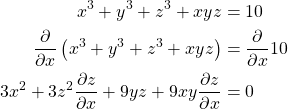5 Multivariate Calculus
So far we have been discussing the calculus of a univariate function, where there is a single independent variable for a dependent variable. In this section, we expand our purview to the functions with multiple independent variables – two, three, or more.
First, let us consider a bivariate function ![]() of two independent variables defined by
of two independent variables defined by
![]()
where ![]() . Often we write in the form of
. Often we write in the form of ![]() , and thus
, and thus ![]() is a dependent variable with independent variables
is a dependent variable with independent variables ![]() and
and ![]() . By adding
. By adding ![]() -axis to the
-axis to the ![]() –
–![]() coordinate plane, we can envisage the function in a 3-dimensional plane.
coordinate plane, we can envisage the function in a 3-dimensional plane.
The same notion applies to a function with ![]() independent variables, though visual representation becomes a challenge. A function
independent variables, though visual representation becomes a challenge. A function ![]() with
with ![]() independent variables would take the form of
independent variables would take the form of
![]()
where ![]() .
.
Partial Differentiation
Imagine a mountain placed on a ![]() –
–![]() –
–![]() coordinate plane. Suppose we are interested in examining the relationship between the height
coordinate plane. Suppose we are interested in examining the relationship between the height ![]() and the rest of the coordinates
and the rest of the coordinates ![]() and
and ![]() . That is, we consider a function
. That is, we consider a function ![]() , where
, where ![]() is a dependent variable and
is a dependent variable and ![]() and
and ![]() are independent variables. What if we are interested in the rate of change in
are independent variables. What if we are interested in the rate of change in ![]() to the change in
to the change in ![]() or
or ![]() ? This is the moment we need to introduce the concept of partial differentiation.
? This is the moment we need to introduce the concept of partial differentiation.
A partial derivative of a multivariate function is defined as a derivative of function with respect to one of the independent variables, while holding the rest of independent variables constant. Suppose we are interested in the relationship between ![]() and
and ![]() holding
holding ![]() constant. Then, the partial derivative of
constant. Then, the partial derivative of ![]() with respect to
with respect to ![]() is
is
![]()
Likewise,
![]()
Different notations for partial derivatives are as follows:
![]()
Now, let us illustrate with a few examples.
Example. Find ![]() and
and ![]() of
of ![]() .
.

Example. Find ![]() of
of ![]() implicitly, where
implicitly, where ![]() is a function of
is a function of ![]() and
and ![]() .
.

Therefore,
![]()
We conclude this section with Clairaut’s Theorem.
Theorem. (Clairaut’s Theorem)
If ![]() is defined on a disk
is defined on a disk ![]() containing the point
containing the point ![]() , and both
, and both ![]() and
and ![]() are continuous on
are continuous on ![]() , then
, then
![]()
The proof is straightforward.
Proof.
![]()
Therefore, ![]() for any
for any ![]() .
.
